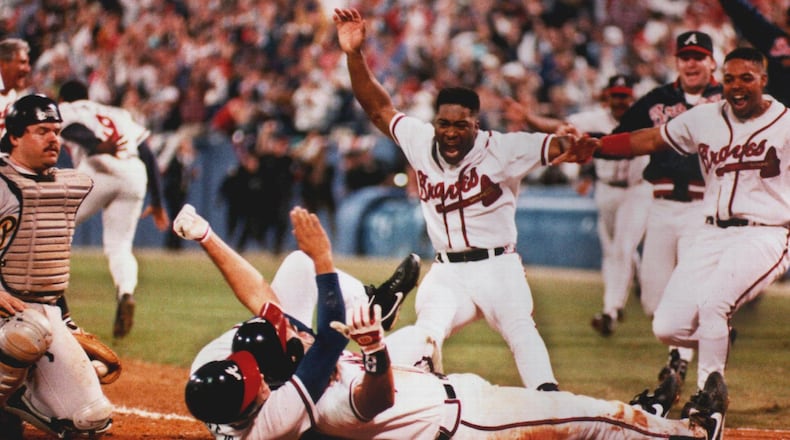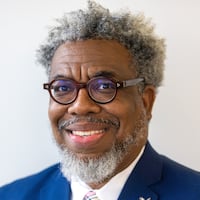Forty-seven years ago, when Dusty Baker watched from the on-deck circle as his hero and mentor, Hank Aaron broke the all-time Major League home run record, the two men represented something special.
Aaron had entered the league as a 20-year-old rookie in 1954, just seven years after Jackie Robinson broke the color line.
Credit: AJC file photo
Credit: AJC file photo
By 1974, the 25-year-old Baker was part of a new generation of Black ballplayers, who had come to dominate the league.
In fact, in the 1970s, Black baseball players made up close to 20% of all Major League baseball players.
Today, as the Atlanta Braves prepare to host Baker’s Houston Astros in Game 3 of the World Series on Friday night, the league is faced with the grim fact that just 7% of the players on opening-day rosters this season were African American.
According to the Society for American Baseball Research (SARB), that number is down from a high of 18.7% in 1981, in a country where Black people currently make up 13.4% of the population, according to the U.S. Census Bureau.
Which begs the question, what happened to all of the Black baseball players?
Even before Jackie Robinson, largely because of the popularity of the Negro Leagues, baseball was once a staple of Black culture.
But experts and studies suggest that the decline of Black baseball players is because fame and fortune come slower in baseball.
NFL and NBA stars come right out of college, and sometimes high school, to big bucks, endorsements, fame, and comfort.
That’s not the case in baseball, which requires a longer maturation process. It can take years in the minor leagues, even out of college, to make it to the big leagues.
Take Aaron Judge for example.
After being drafted in the first round out of college by the New York Yankees in 2013, he made his brief major league debut in 2016 at the age of 24. In 2017, he won the American League Rookie of the Year and finished second in the MVP race after clubbing 52 home runs.
But while Judge has become the face of baseball, making about $10 million a year, he won’t be a free agent and eligible for a massive contract until after next season when he will be 31 years old.
Now take Kyler Murray, a two-sport star out of the University of Oklahoma. As a left fielder for the Sooners, he was drafted by the Oakland Athletics as the ninth selection in the 2018 MLB draft, complete with a $4.6 million signing bonus.
But the next year, after winning the Heisman Trophy, Murray was the first overall pick in the NFL draft and immediately signed a four-year rookie contract worth $35.2 million.
There is also the issue of affordability. The best youth players play on year-round travel teams and are afforded quality equipment and private coaches. Travel costs alone make it impossible for kids from underserved communities to even participate, making it harder to get exposure, scholarships and a shot at getting drafted.
It seems easier to be the next LeBron James or Patrick Mahomes than it is to be the next Ken Griffey Jr.
In an effort to address the problem, MLB have created programs like Hank Aaron Invitational, where the best Black players in the country work with coaches and former players like Dave Winfield and Marquis Grissom for elite-level training.
It would be misleading to suggest that the lack of Black players has sapped diversity out of Major League Baseball. But today’s baseball landscape looks less like Jackie Robinson and more like Roberto Clemente, the first Latino to be inducted into the Baseball Hall of Fame.
According to the MLB, Latino players make up 25% of the active players currently in the league, with most of them coming from the Dominican Republic, Venezuela and Cuba, countries where baseball is a national sport.
According to SARB, Latin players surpassed the number of Black players for the first time in 1993 and haven’t looked back. Today, baseball’s most exciting and best young players, including Fernando Tatis Jr., Juan Soto, Francisco Lindor and the Braves’ Ozzie Albies and Ronald Acuna Jr., are Latino.
What is so disturbing about the decline of American-born Black baseball players is the fact that at once, they were so dominant.
In a profile I did on Hank Aaron in 2020, I noted that Robinson won the first-ever Rookie of the Year Award in 1947. Between 1949 and 1958, eight of the 11 National League winners were Black. Between 1949, when Robinson won the National League Most Valuable Player, and 1969, African Americans and Latinos would win the award 16 times. In the 1990s and 2000s, Barry Bonds would win the award seven times.
Credit: Julie Jacobson, Associated Press
Credit: Julie Jacobson, Associated Press
Bonds would go on to pass Aaron as the all-time home run leader. But no one has driven in more runs than Aaron. No one has scored more runs or stolen more bases than Ricky Henderson.
One wonders if those numbers will ever be duplicated, although there is hope with players like Mookie Betts of the Dodgers, Tim Anderson of the White Sox, Giancarlo Stanton of the Yankees, Marcus Stroman of the Mets and Michael Brantley of the Astros.
The Braves?
Our lone American-born Black player right now is pinch-runner Terrance Gore, who was added to the roster as a late-inning threat.
Credit: TNS
Credit: TNS
Tuesday’s Game One early inning threat was provided by Jorge Soler, a native of Cuba, who launched a leadoff home run off of the Astros’ Framber Valdez, a Dominican.
About the Author
Keep Reading
The Latest
Featured







